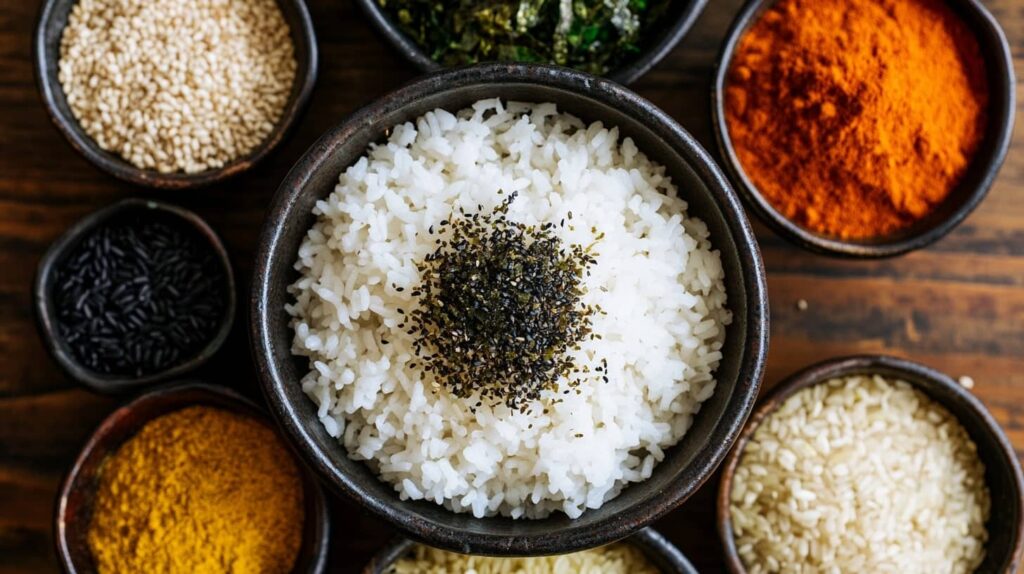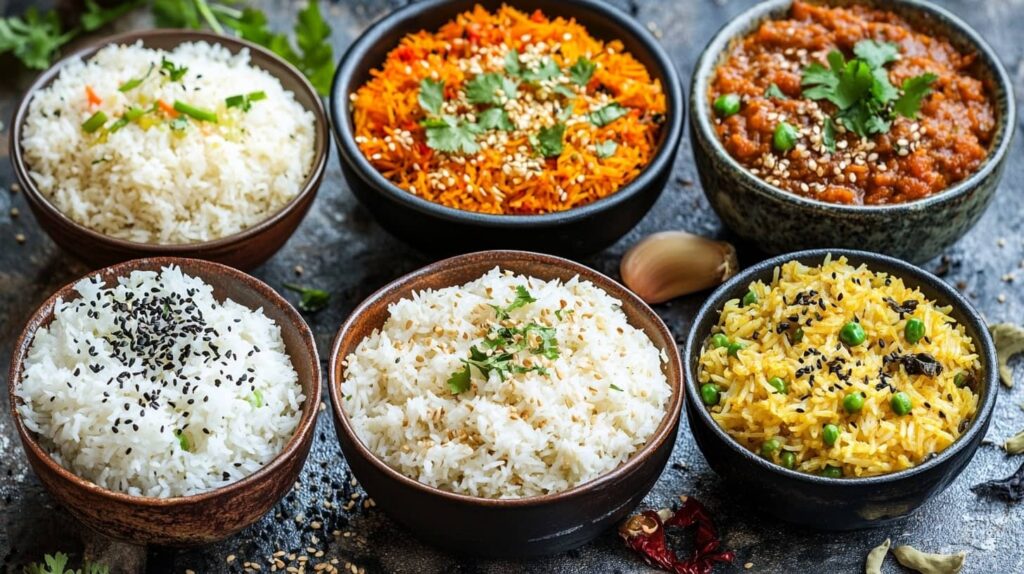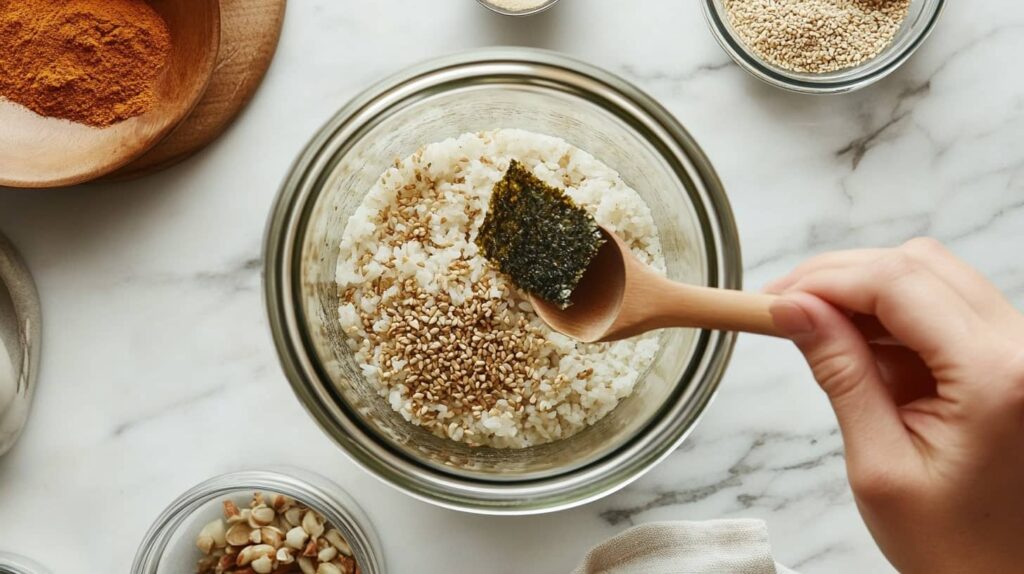
Rice is more than just a side dish—it’s a canvas for flavors! But have you ever wondered what makes seasoned rice taste so irresistible? That’s where rice seasoning comes into play. From savory spices to crunchy toppings, rice seasoning transforms plain grains into a feast for your taste buds. In this article, we’ll break down everything you need to know about rice seasoning, what it’s made of, and how you can use it to level up your meals! 🌾🍚
Table of contents
Introduction to Rice Seasoning: A Flavorful Culinary Essential
Rice is a staple food enjoyed by billions of people worldwide. But plain rice can sometimes feel a little… well, plain. That’s where rice seasoning steps in to add life to this humble grain. Whether it’s sprinkled on top or mixed in during cooking, seasoning can turn rice into a show-stopping dish.
Imagine your rice dressed up in vibrant colors, rich aromas, and tantalizing flavors. Doesn’t that sound exciting? Well, that’s exactly what rice seasoning does—it’s like a magic wand for your meals!
“Rice seasoning isn’t just an ingredient; it’s a gateway to different cultures and cuisines.”
So, let’s dive deeper and uncover the mysteries behind this culinary hero. 🌟
The Basics: What is Rice Seasoning?
Defining Rice Seasoning and Its Culinary Importance
Rice seasoning is a blend of herbs, spices, and other flavorful ingredients designed to enhance the taste of rice. It can be savory, spicy, tangy, or even slightly sweet, depending on the type of dish you’re preparing.
Rice seasoning is widely used in dishes like sushi, fried rice, biryani, and pilaf. It’s popular across Asia, Latin America, and the Mediterranean, proving that flavor knows no boundaries. 🌍
Fun Fact: The Japanese word for rice seasoning is “Furikake,” which literally means “to sprinkle.” It’s often used to add crunch, umami, and color to plain rice.
Historical Origins of Rice Seasoning in Global Cuisines
Seasoned rice has ancient roots, dating back thousands of years.
- Japan: Furikake was created during the early 20th century as a calcium supplement. Today, it’s a flavorful topping made from sesame seeds, seaweed, and dried fish.
- India: Biryani and pulao spice mixes were developed centuries ago using fragrant spices like cumin, cardamom, and saffron.
- Latin America: Cilantro-lime rice, influenced by Spanish cooking, combines herbs and citrus for a refreshing taste.
- Korea: Gochujang (spicy red chili paste) and sesame oil seasonings are traditional staples in bibimbap and mixed rice bowls.
“Seasoned rice tells a story of culture, history, and tradition, all packed into a single bite.”
Key Ingredients in Rice Seasoning
Now, let’s dig into the most common ingredients you’ll find in rice seasoning and what makes each one special.
Common Herbs and Spices in Rice Seasonings
- Garlic Powder: Adds a punchy, savory flavor that pairs perfectly with most dishes.
- Onion Powder: Provides a subtle sweetness and depth.
- Cumin: A warm, earthy spice often used in Indian and Middle Eastern rice dishes.
- Paprika: Adds both color and a mild smoky taste.
- Turmeric: Known for its vibrant yellow color and earthy flavor, especially in Indian dishes.
Pro Tip: Mixing garlic and onion powder creates a dynamic flavor base for any rice dish!
Umami Boosters: Soy Sauce, Miso, and Dashi
Umami is often called the “fifth taste,” and it’s the secret behind deeply satisfying flavors.
- Soy Sauce: Adds saltiness and complexity.
- Miso Paste: A fermented soybean product that brings richness.
- Dashi: A Japanese broth made from seaweed and fish flakes, delivering intense umami flavor.
“Umami ingredients make rice taste richer, fuller, and downright irresistible.”
Sweet and Savory Additives: Sugar, Vinegar, and Sesame Oil
A balance of sweet and savory flavors can make rice seasoning truly shine.
- Sugar: Used to soften the intensity of vinegar in sushi rice.
- Rice Vinegar: Adds a tangy kick and enhances the overall flavor profile.
- Sesame Oil: Provides nuttiness and aroma, especially in Asian dishes.
“The secret to mouthwatering rice? A balance of sweet, salty, and tangy flavors!”
Crunchy Toppings: Sesame Seeds, Nori, and Furikake
Crunchy elements make rice dishes more exciting and texturally appealing.
- Sesame Seeds: Nutty and aromatic, great for sprinkling on top.
- Nori (Seaweed): Adds a briny, ocean-like flavor perfect for sushi.
- Furikake: A Japanese blend of sesame seeds, dried fish, and seaweed that’s both crunchy and savory.
“Texture matters—add crunch for an unforgettable rice experience!”
Table: Common Ingredients in Rice Seasoning
| Ingredient | Type | Purpose |
|---|---|---|
| Garlic Powder | Spice | Savory flavor base |
| Sesame Oil | Oil | Nutty aroma and richness |
| Soy Sauce | Liquid flavor | Umami and saltiness |
| Nori (Seaweed) | Topping | Crunch and briny flavor |
| Turmeric | Spice | Earthy taste and vibrant color |
| Rice Vinegar | Liquid flavor | Tangy balance for sweetness |
| Furikake | Seasoning Mix | Crunch, saltiness, and umami |
Why Rice Seasoning Matters
Rice seasoning does more than just add flavor—it elevates the dining experience. Think of it as the cherry on top of a sundae. It’s that finishing touch that makes a dish go from ordinary to extraordinary.
“Seasoning transforms plain rice into a world of flavors, letting every bite tell a delicious story.”
Popular Types of Rice Seasonings Around the World

Rice seasoning isn’t one-size-fits-all. Different cultures have created their own unique blends to suit their cuisines. Let’s take a world tour of rice seasonings! 🌍
Japanese Furikake: Flavorful Flakes for Sushi Rice
Japanese furikake is arguably one of the most famous rice seasonings. It’s a crunchy, umami-rich topping that can instantly transform plain rice into something special.
Key Ingredients in Furikake:
- Seaweed (Nori): Adds briny flavor and crunch.
- Sesame Seeds: Provides nuttiness and texture.
- Bonito Flakes: Dried fish flakes for an umami boost.
- Salt and Sugar: Balances the flavors.
- Wasabi or Spices: Optional for heat and flavor.
“Furikake is like confetti for rice—colorful, exciting, and full of flavor!”
Korean Rice Seasonings: Gochujang and Sesame Oil Mixes
Korean cuisine offers bold, spicy flavors, and their rice seasonings are no exception. Bibimbap and kimchi fried rice are perfect examples of Korean-style seasoned rice.
Key Ingredients in Korean Rice Seasonings:
- Gochujang (Red Chili Paste): Spicy, sweet, and savory all at once.
- Sesame Oil: Adds nuttiness and a glossy texture.
- Soy Sauce: Enhances umami flavor.
- Garlic and Green Onions: Aromatic and flavorful.
“Korean rice seasoning is a flavor explosion—perfect for spice lovers!” 🌶️
Indian Spice Blends for Biryani and Pulao
Indian rice dishes like biryani and pulao are known for their aromatic spices and rich flavors. These blends create dishes that are both flavorful and colorful.
Common Ingredients in Indian Rice Seasonings:
- Cumin and Coriander Seeds: Earthy and fragrant.
- Turmeric: Adds color and warmth.
- Cinnamon and Cloves: Provides sweet and spicy notes.
- Saffron: Luxurious and aromatic.
“Indian rice seasonings turn every meal into a royal feast!” 👑
Latin American Cilantro-Lime Seasonings
Latin American cuisines often feature zesty, herbaceous flavors in their rice dishes. Think cilantro-lime rice, often served alongside tacos or grilled meats.
Key Ingredients in Latin Seasonings:
- Cilantro: Fresh and vibrant.
- Lime Juice: Adds a tangy kick.
- Garlic and Onion Powder: Enhances flavor depth.
- Olive Oil: For richness and moisture.
“Latin seasonings bring a fiesta of flavors to your table!” 🎉
Mediterranean Herb-Infused Rice Flavorings
Mediterranean rice dishes often use herbs and olive oil to create light yet flavorful meals.
Key Ingredients in Mediterranean Seasonings:
- Parsley and Dill: Fresh and aromatic.
- Lemon Zest: Brightens the flavor.
- Olive Oil: Adds richness.
- Garlic and Paprika: Provides warmth and depth.
“Mediterranean rice seasoning is like sunshine in a bowl—fresh, light, and delightful!” ☀️
How to Make Homemade Rice Seasoning: Step-by-Step Guide

Why buy pre-made seasonings when you can create your own? Here’s a simple guide to making rice seasoning at home.
Essential Tools and Ingredients
- Mixing Bowls: For combining ingredients.
- Measuring Spoons: For accuracy.
- Airtight Containers: To store the seasoning.
Key Ingredients for Basic Rice Seasoning:
- 2 tbsp sesame seeds
- 1 tbsp nori flakes
- 1 tsp garlic powder
- 1 tsp onion powder
- ½ tsp sugar
- ½ tsp salt
- Optional: red pepper flakes for heat
Steps to Prepare Homemade Rice Seasoning
- Toast Sesame Seeds: Heat sesame seeds in a dry pan until golden brown. Stir constantly to avoid burning.
- Crush Nori Flakes: Tear seaweed sheets into small pieces or crush them in a blender.
- Mix Ingredients: Combine toasted sesame seeds, nori, garlic powder, onion powder, sugar, and salt in a bowl.
- Taste and Adjust: Add more salt, sugar, or spices to match your preferences.
- Store Properly: Transfer the mixture to an airtight container to keep it fresh.
“Homemade rice seasoning is quick, affordable, and endlessly customizable!” 🥢
Tips for Storing Homemade Rice Seasonings
- Keep it Dry: Moisture can make the seasoning clump. Always store it in a cool, dry place.
- Use Glass Jars: Glass containers seal better and preserve freshness.
- Label and Date: Write the date on the jar to keep track of its shelf life.
Pro Tip: Homemade seasonings typically last 2–3 months when stored properly.
Benefits of Using Rice Seasonings in Cooking
Still not convinced? Here’s why rice seasoning is worth keeping in your kitchen:
- Enhances Flavor Without Calories: Many seasonings add taste without piling on calories.
- Improves Presentation: Adds color and texture, making dishes visually appealing.
- Versatility: Works with plain rice, fried rice, sushi, or even noodle dishes.
- Health Boost: Ingredients like sesame seeds and seaweed add nutrients like calcium and iodine.
Table: Nutrition Facts of Furikake Rice Seasoning
| Nutrient | Amount per Serving (1 tbsp) |
|---|---|
| Calories | 20 |
| Fat | 1g |
| Sodium | 100mg |
| Protein | 1g |
| Fiber | 0.5g |
| Iron | 2% DV |
Common Problems and Solutions with Rice Seasoning
Seasoning rice seems simple, but sometimes things don’t go as planned. Let’s address some common hiccups and how to fix them!
1. Too Salty or Too Bland? Adjusting Flavor Balance
Problem:
You’ve added too much salt, or your rice tastes too bland.
Solution:
- Too Salty? Add more plain cooked rice to dilute the seasoning. Alternatively, mix in a splash of lemon juice or vinegar to cut through the saltiness.
- Too Bland? Sprinkle additional seasoning on top or stir in soy sauce, sesame oil, or a dash of hot sauce for instant flavor.
“Seasoning is all about balance—adjusting flavors is part of the art!”
2. Seasoning Clumps: Tips for Proper Mixing
Problem:
Seasoning clumps together instead of spreading evenly.
Solution:
- Use a fork to fluff the rice while mixing.
- Sprinkle seasoning in layers as you stir instead of adding it all at once.
- If using powdered seasonings, mix them with a small amount of oil or water before adding them to the rice for even distribution.
“Good seasoning is like confetti—it should spread evenly for maximum impact!”
3. Storage Issues: Preventing Moisture and Spoilage
Problem:
Homemade or store-bought seasonings lose flavor or get clumpy over time.
Solution:
- Store seasonings in airtight containers.
- Add a few grains of uncooked rice to the container to absorb moisture.
- Keep the container away from heat and direct sunlight.
Pro Tip: Freeze seasoning blends containing fresh herbs to preserve their flavor longer! ❄️
Choosing the Right Rice Seasoning for Different Recipes
Rice seasonings can make or break a dish, so it’s important to pair the right flavor profile with the recipe you’re preparing.
Best Seasonings for Specific Dishes
| Dish Type | Recommended Seasoning |
|---|---|
| Sushi Rice | Furikake, rice vinegar, sugar, and salt. |
| Fried Rice | Soy sauce, garlic, sesame oil, and green onions. |
| Biryani or Pulao | Cumin, saffron, cardamom, and turmeric. |
| Latin Rice Dishes | Cilantro, lime, and chili powder. |
| Mediterranean Rice | Parsley, dill, lemon zest, and olive oil. |
“Pair your seasoning like a pro—matching flavors to your dish creates harmony!”
Health Considerations When Using Rice Seasoning
While rice seasonings add flavor, it’s important to pay attention to their nutritional impact, especially for those with dietary restrictions.
Low-Sodium and Gluten-Free Alternatives
- Replace soy sauce with tamari or coconut aminos for a gluten-free option.
- Opt for herb-based blends instead of salt-heavy seasonings.
- Use low-sodium soy sauce or reduce salt and add citrus flavors for balance.
Vegan and Vegetarian-Friendly Seasoning Options
- Avoid seasonings with dried fish flakes (common in Furikake) and opt for seaweed, sesame seeds, and chili flakes instead.
- Add nutritional yeast for a cheesy, savory flavor.
“Healthy doesn’t have to be boring—season smart and eat happy!” 🥗
Where to Buy Quality Rice Seasonings
Top Brands and Online Stores
- Kikkoman Furikake: Widely available and known for quality.
- Ajinomoto Seasonings: Offers traditional Japanese flavors.
- Trader Joe’s Seasonings: Affordable and versatile options.
- Amazon and Walmart: Convenient for bulk orders and specialty blends.
Local Markets and Asian Grocery Stores
- Visit Asian markets for authentic flavors like Japanese Furikake or Korean Gochugaru.
- Latin markets often carry cilantro-lime blends and other regional spices.
“Finding great seasoning is like finding treasure—explore and experiment!”
Frequently Asked Questions (FAQs)
1. Is Rice Seasoning Healthy?
Yes, most rice seasonings are healthy, especially those with herbs, seeds, and seaweed. However, watch out for high sodium levels in store-bought options.
2. Can You Use Rice Seasoning for Other Dishes?
Absolutely! Rice seasoning works on noodles, salads, soups, and even roasted vegetables.
3. How Long Does Rice Seasoning Last?
Store-bought seasoning lasts 6–12 months, while homemade blends stay fresh for 2–3 months if stored properly.
4. Are There Allergy Concerns with Rice Seasonings?
Yes, some may contain allergens like sesame, soy, or seafood. Always check labels if you have dietary restrictions.
5. What is the Best Substitute for Rice Seasoning?
You can mix garlic powder, sesame seeds, and seaweed flakes as a quick substitute.
6. Can I Make Rice Seasoning Without Salt?
Of course! Focus on herbs, citrus zest, and spices for a salt-free blend.
Explore More Delicious Recipes and Tips!
If you enjoyed learning about rice seasonings and how to transform plain rice into a flavorful masterpiece, there’s more to discover! Check out these exciting guides and recipes to keep your culinary creativity flowing:
- Rice Cakes: Benefits and Recipes for Healthy Snacking – Discover how rice cakes can be both healthy and tasty with these easy recipes. 🍘
- Are Rice Cakes Actually Healthy? – Uncover the truth about rice cakes and how to make them a nutritious part of your diet. 🌾
- Rice Spice Ideas: How to Make Your Meals Unforgettable – Find unique spice combinations to elevate your rice dishes to the next level. 🌟
- What Spices to Put in Rice? Create Aromatic Dishes Now! – Learn about the best spices to add to rice for bold, mouthwatering flavors. 🍛
Ready to keep cooking? Explore these recipes and seasoning tips to make every meal unforgettable! 🌍✨
Conclusion: Elevate Your Meals with Rice Seasoning
Rice seasoning isn’t just a condiment—it’s a passport to a world of flavors. Whether you prefer the umami-rich taste of Japanese Furikake, the fiery heat of Korean gochujang, or the aromatic spices of Indian biryani, there’s a seasoning for every palate.
Why settle for plain rice when you can turn it into a masterpiece? With the tips, recipes, and solutions shared in this guide, you’re now ready to experiment and create flavorful rice dishes that everyone will love! 🌟
So go ahead—grab your spices, mix up a blend, and let your taste buds travel the world, one bite at a time! 🌎🍚
